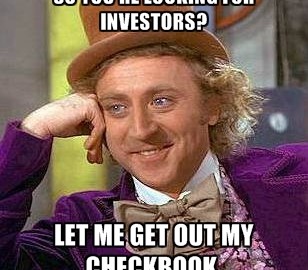Make your Pitch “Real” From Day One
What a Pitch Really Is
Raising money is a deeply complex issue for a startup. We won’t reinvent the wheel here and now and tell you whether you’re even ready to try doing it. But we will talk about your “pitch.”
Founders often enter the pitch under the false assumption that investors are looking for someone like them. Someone who feels like a peer, whose job it is to convince them. Paul Graham of Y Combinator wrote about this recently
“When people hurt themselves lifting heavy things, it’s usually because they try to lift with their back. The right way to lift heavy things is to let your legs do the work. Inexperienced founders make the same mistake when trying to convince investors. They try to convince with their pitch. Most would be better off if they let their startup do the work—if they started by understanding why their startup is worth investing in, then simply explained this well to investors.” – Paul Graham (Full Article here)But your pitch is more than just a magical set of keywords that unlocks a golden elevator, filled with swimsuit models holding champagne flutes and suitcases full of money. The secret handshake theory of business is only attractive to those who aren’t sure who their customers are: investors or actual potential clients.
No, your pitch might be closer to your “identity,” as an early stage startup. Your pitch is not just your idea. That bears repeating. Your pitch is not just your idea: it is a demonstration of why you are a good bet. It’s also the first and consequently most important way that people will know you. VCs, angels, accelerators and even potential employees know you by your pitch. And avoiding the biggest mistakes, can be as key as making the best sounding pitch.
A Pitch is Creating a New Reality
One in which your product is real, and one in which it is something that customers need, and will pay for. This is why your pitch is not your idea. Your idea is plastic, and can change, but the reality you are pitching has to be real. Your product solves real problems.
And your pitch starts from day one. You should come up with a pitch that makes sense before going any further, because if you can’t sell your product, there may be little point in building it. This ice-cream shotgun is still genius, by the way, but the pitch didn’t work out, so I’m waiting for the market to present a need before investing.
What’s in the Pitch
This is a “positioning template” first suggested by Geoffrey Moore in Crossing the Chasm, a modern day “bible” for technology marketing. See if the pitch you have at the top of your head addresses each of these points in a meaningful way:
For (target customers)
Who (have the following problem)
Our product is a (describe the product or solution)
That provides (cite the breakthrough capability)
Unlike (reference competition),
Our product/solution (describe the key point of competitive differentiation)
In this post we’re primarily concerned with the first half of this template.
Create the Problem
All products and innovations address problems, and this is the For, and Who, and Unlike, of your pitch. A person/company/institution with an issue/need/lack/goal.
When entering your pitch, you should have in mind a typical customer who has a common enough problem. This works for anything- you just need to be creative. You are not inventing the need, but you are formulating its basis.
Nobody needed an electric typewriter in 1924 when IBM obtained patents that would later be used in its first commercial models. But there were key deficiencies in the design of manual typewriters, that caused common, known problems. Problems that could be solved. IBM identified those deficiencies, and attempted to eliminate them.
There was no work not being done because of these deficiencies; nobody was sitting around waiting for the automatic typewriter, but companies and individuals still invested in the new technology, not because they were aware of how automatic typewriters would revolutionize business, but because it solved problems they knew they already had.
Here’s a pitch for the electric typwriter, in this frame (freely invented by me):
There are over 50 million typists, secretaries, students and amateur writers in America all grappling with the same issues. Current typewriters on the market have frequent jams, rust easily, cause pain in the fingers due to the difficulty of depressing keys, and create type which is often uneven, and illegible. Our new automatic typewriter solves all of those problems, using revolutionary new technology that prevents jamming, ensures even spacing, and is easy on the fingers. It produces clear, legible, even type, at a speed before totally unprecedented, allowing typists to work more productively, more quickly, and more happily. Better yet, it is cheaper to manufacture than a manual typewriter, accepting universally interchangeable parts.You’ll find every element of the above template present. Who the product is for (and size of the market), what their problems are, what the competition offers, what our product is, and how it solves all of those problems, along with a litany of killer features, and even a case for profitability. It presents the investor with a world that is broken (typing sucks and it’s expensive), and then presents the solution (typing made easier and cheaper).
That is the sort of pitch that grew IBM’s revenue by a factor of 20 in 20 years, and its profits by a factor of 7 in the same time period. All based on solving basic deficiencies in its marketplace.
Not all products are as glamorous to you and I as the automatic typewriter. But think about the executives who funded its development in 1925. They didn’t touch typewriters. They had secretaries who did that, and they dictated letters or scratched notes on paper. Typewriters were manual labor, and beneath their pay grades.
Give the Solution
These people had to be convinced that a problem existed, and that others, office managers, schools, and institutions of government, would buy the solution, before they invested in buying the patents and funding its development as a commercial product. The pitch provides the investor with a reason why the product is needed, the evidence that there is a market for it, the evidence that the market will accept it, and the evidence that this will be a profitable venture.
And this kind of pitch can be given in 30 seconds, or in 30 minutes. If it makes the problem and the solution real, it can win an investment.
So however tedious the problems that you’re solving are, if you believe there’s a market for the solutions you offer, you have to make those problems real to investors. Presenting a killer solution, even when the status quo still works, is the key to making the problem real for an investor. Make that investor see the current state of affairs as a net loss, instead of a zero sum.
[ssba]






